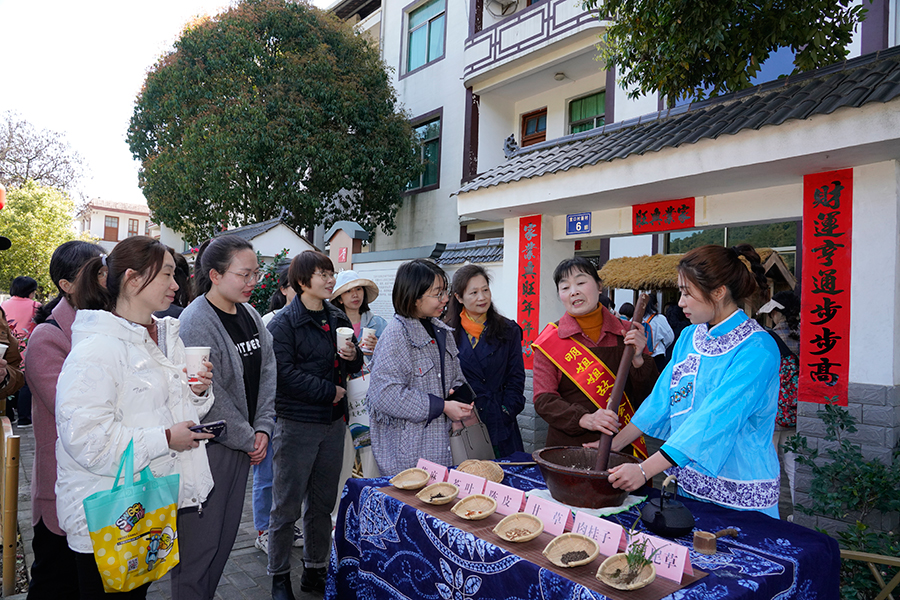Modern cultivation techniques bearing fruit in mountain village


Thanks to the monitoring system, Xu has also introduced an orange tree adoption program. Clients can learn all they need to know about the trees they adopt — including irrigation, fertilization and the use of pesticides — in a real-time manner.
Xu has introduced a number of eco-friendly approaches in the orchard. To reduce fertilizer use, for instance, "green manure" is planted under orange trees. "Green manure" refers to fast-growing plants that are sown to cover bare soil. They can return valuable nutrients to the soil and improve its structure after being planted while still green.
The local high-quality natural environment and the eco-friendly cultivation approaches mean that Xu's oranges can be sold for high prices at market.
"The price of navel oranges from my orchard ranges from 10 yuan to 12 yuan per kilogram.The market price of the fruit usually stands at 8 yuan to 12 yuan per kg," he said.
His navel oranges are sold in many large cities such as Shanghai and Nanjing, capital of Jiangsu province. "They sell well," he said.
Xu said he pays the Changkou village committee 30,000 yuan a year for each hectare of farmland he rents. Meanwhile, many villagers can each earn 40,000 yuan to 60,000 yuan a year by working in his orchard.
He has also expanded his navel orange orchards to several other villages. In total, the orchards cover about 267 hectares and host roughly 220,000 trees.
According to local authorities, Xu's business is expected to raise the incomes of local villagers and village committees by 4 million yuan a year starting in 2025, when all of the trees will start yield fruit.
In addition to 100 full-time employees, the operation of Xu's orchards requires about 700 temporary workers in peak harvest seasons.
Apart from navel oranges, Changkou has also brought in vegetable, flower and mushroom industries, which all make full use of the natural environment, according to the village committee.
In addition to eco-agriculture, ecotourism has continued to boom in Changkou, with the village receiving about 50,000 tourists a year, it said.
In 2012, a tourism company called Yunqushan launched a rafting project in the village with investment of 20 million yuan. Without having to make any investment in the project, the village committee became a shareholder through Changkou's land and the livable environment.Each year, the committee receives 10 percent of the project's gate receipts.
Chen Zubiao, Yunqushan's general manager,said the company invested a further 2.6 million yuan in 2019 to expand its facilities after seeing consistent surges in the number of tourists arriving.
Also attracted by the village's pleasant environment, the Fujian Tourism Development Group decided to start a tourism program in the village in 2019 with total investment of 600 million yuan.
According to the agreement the village reached with the company, the project aims to build the settlement into a sanitarium-like ecotourism base so people can visit not only for sightseeing, but also for health treatments.Facilities will also be built for environmental education programs to promote the philosophy that "lucid waters and lush mountains are invaluable assets".
While some villagers choose to work for companies that come to invest in Changkou, others have started their own businesses. Yang Fuchun, for example, started a rural resort in his three-story house in 2017. Previously, he and his wife could make only about 50,000 yuan a year as migrant workers, but now the business brings them annual income of more than 100,000 yuan, he told Fujian Daily.
Luo Peiying, an official with the Changkou village committee, said the residents can lease their empty properties to the village committee to assist the development of tourism. They not only earn rental income, but receive dividends from the operating revenues.
With 1,267 hectares of woodland in total,Changkou has a forest coverage rate of 92 percent. Since 2021, when local authorities introduced a forest carbon credit mechanism, the villagers have benefited financially from the forest they have safeguarded for generations.
Forest carbon credits are calculated based on the amount of carbon dioxide that is captured by added woodland areas. As a market instrument, it is used in many countries to encourage afforestation.
Emitters of carbon dioxide can buy the credits to offset the gases they generate, while the credits can also serve as collateral for bank credit and loans.
As China forges ahead with its climate targets of peaking carbon dioxide emissions before 2030 and achieving carbon neutrality before 2060, the country has vowed to beef up afforestation so that more carbon dioxide can be absorbed from the atmosphere.
On May 18, 2021, the village received the country's first carbon credit stamp from the local forestry administration for 213 hectares of its woodland. A third-party assessment shows that the forest absorbed 12,723 metric tons of carbon dioxide from 2016 to 2020. The credit was quickly sold for about 140,000 yuan,according to local authorities.
"All the money has been distributed to villagers as a dividend. Each villager got 150 yuan," said Deng Wanfu, Changkou's Party chief. The local forestry administration is issuing the second forest carbon credit stamp for the village,he told Fujian Daily.
The new stamp is for almost 479 hectares of forest, and the total credit this time amounts to 21,139 tons of carbon dioxide.
Thanks to a surge in the price, Deng expects that the credit will bring the village 600,000 yuan in income. "Once we sell the credit, we will distribute dividends to the villagers again," he said.





































